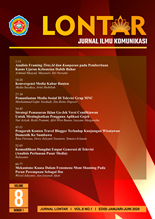PEMANFAATAN MEDIA SOSIAL DI TELEVISI GRUP MNC
DOI:
https://doi.org/10.30656/lontar.v8i1.1540Keywords:
Televisi, konvergensi, media sosial, MNCAbstract
Pengguna media sosial semakin meningkat, seiring dengan tumbuhnya pengguna internet dan perangkat komunikasi bergerak. Generasi muda lebih banyak memilih media sosial untuk mencari informasi dan hiburan. Akibatnya media lama seperti televisi mulai ditinggalkan penonton. Dampak selanjutnya pemasang iklan di televisi cenderung berkurang. Dalam teori konvergensi media (Pavlik, 2001), untuk mempertahankan hdiupnya, media lama harus mengadopsi teknologi media baru, sehingga kontennya dapat tampil pada media yang beragam (multi-platform). Mau tak mau televisi harus memanfaatkan media sosial untuk mempertahankan penonton setianya dan menjangkau pengguna media sosial agar menonton berita televisi. Grup MNC yang memiliki empat stasiun televisi free to air, iNews, RCTI, MNC, Global TV, mulai membangun media sosialnya. Penelitian ini menggambarkan kegiatan tim media sosial MNC dalam memanfaatkan media sosial. Penelitian ini menggunakan perspektif kualitatif bersifat deskriptif dengan metode studi kasus. Pengumpulan data dilakukan dengan wawancara mendalam, observasi dan dokumentasi. Kesimpulan dari penelitian ini adalah MNC menggunakan media sosial untuk mempromosikan program-program beritanya. Media sosial menjadi layar berikutnya untuk konten televisi. Tim media sosial MNC tidak hanya bekerja sebagai pengunggah konten program berita yang sudah tayang di televisi(content uploader), tapi juga menjadi pencipta konten (content creator) media sosial. Kurasi berita yang tampil dilakukan oleh tim media sosial.
References
Aguilar, M Gomes; Rojano, FJ Paniagua, Batlle, P Farias. (2015). The behaviour of the television audience on social networks. An approach to its profile and the most talked-about programmes. Revista Latina de Comunicación Social, 70, 539-551. DOI: 10.4185/RLCS-2015-1058en
Bell, Emily J., Taylor Owen, Peter D. Brown, Codi Hauka, and Nushin Rashidian. (2017). The platform press: How silicon valley reengineered journalism. New York: Tow Center, Columbia University.
Cahyono, A. S. (2016). Pengaruh media sosial terhadap perubahan sosial masyarakat Indonesia. Jurnal Publisiana , 9(1), 140-157.
Es, Karin van. (2016). Social TV and the Participation Dilemma in NBC’s The Voice. Television & New Media. 17(2), 108–123. DOI: 10.1177/1527476415616191
Febriana, Ajeng Iva Dwi. (2018). Determenisme teknologi dan tutupnya sosial media path. Jurnal Lontar. 6 (2), 10-17.
Fuchs, Christian, (2014). Social media: A critical introduction. Thousand Oaks, CA: SAGE
Grant, Agust E; Wilkinson, Jeffrey. (2009). Understanding media convergence: the state, the field. New York/Oxford: Oxford University Press.
Hermida, Alfred, Fletcher, Fred, Korell, Darryl & Logan, Donna (2012). Share, like, recommend. Decoding the social media news consumer, Journalism Studies, 13 (5-6),815-824. DOI:10.1080/1461670X.2012.664430
Jenkins, Henry. (2006). Convergence culture: Where old and new media collide. New York & London: New York University Press.
Johansson, Anders C. (2016). Social media and politics in Indonesia. Stockholm School of Economics Asia Working Paper No. 42. Stockholm China Economic Research Institute. Stockholm School of Economics
Jones, C., & Shao, B. (2011). The net generation and digital native: Implication on higer education. A literature review commisionned by the higher education academy. The Institute of Educational Technology, The Open University, Walton Hall, Milton Keynes
Kaplan, A., Haenlein, M. (2012). Social media: back to the roots and back to the future. Journal of System and Information Technology , 14 (2), 101-104. DOI 10.1108/13287261211232126
Katadata, C. I. (2018, April 11). Katadata Co Id. Diakses 17 Juli 2018, dari http://databooks.katadata.co.id/datapublish/2018/04/11/berapa-jumlah-pengguna-facebook-di-indonesia
Klemm, R. K., & Brites, M. J. (2017). How digital converges cross-media news typologies a cross countries: A comparative study of news consumtion in Estonia and Portugal. Journal of Audiences & Reception Studies , 14 (2), 464-483. Diakses dari https://www.academia.edu/35400658/Comparison_of_news_consumption_on_online_among_Estonian_and_Portuguese_audience
Kriyantono, Rahmat. (2007). Teknik praktis riset komunikasi. Jakarta: Kencana Prenada Media Group.
Lee, Francis; Chan, Michael; Chen, Hsuan-Ting; Leung, Dennis; Kalegeropoulus, Antonis; Nielsen, Rasmus Kleis. (2017). Reuters institute digital news report 2017: Asia Pasific suplementary report. The Chinese University of Hong Kong.
Lim, M. (2013). Many cliks, but little sticks: social media activism in Indonesia. Journal of Contemporary Asia , 43(4), 636-657. DOI:10.1080/00472336.2013.769386
Luc Chia-Shin Lin. (2017). Mobile apps and news: a Taiwanese case of curation, The Journal of International Communication. 1-20. DOI: 10.1080/13216597.2017.1419983
Meulenaere, Jonas De; Bleumers, Lizzy; Van den Broeck, Wendy. (2015). An audience perspective on the second screen phenomenon. The Journal of Media Innovations, 2(2), 6–22. DOI: http://dx.doi.org/10.5617/jmi.v2i2.909
Miles, Matthew B; Huberman, A. Michael. (2009). Analisis data kualitatif: Buku sumber tentang metode-metode baru. Jakarta: UI Press.
Muslikhin. (2017). Television news in the social media era. Proceeding The 1st International Conference on Social Science. (327-338).
Pavlik, J. (2001). Journalism and new media. New York: Columbia University Press.
Rahardjo, Mudjia. (2017). Studi kasus dalam penelitian kualitatif: Konsep dan Prosedur. Malang: Pasca Sarjana UIN.
Downloads
Published
Issue
Section
License
By submitting an article to the journal, the author(s) agree to transfer the published article's copyright to the journal, which will act as the publisher. This means the journal will have the right to publish the article in various forms, including reprints. The journal will maintain the publishing rights to the published articles.
In line with the license, authors and third parties (readers, researchers, and others) are allowed to share and adapt the material. In addition, the material must be given appropriate credit, provided with a link to the license, and indicated if changes were made. If authors remix, transform, or build upon the material, authors must distribute their contributions under the same license as the original.






